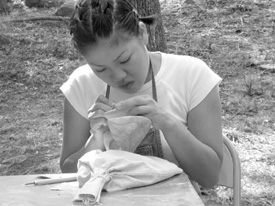Graduate keeps ELI T-shirt, wins UD art award
 |
|
ELI Grad Kunie Yamanaka won an undergraduate award for her sculpting |
“I still have the T-shirt.”
Kunie Yamanaka, ELI alum and an undergraduate art major at the University of Delaware, recalls her graduation from the English Language Institute in August 2001. As valedictorian of her class, Yamanaka received the famed ELI honors T-shirt to mark her status as an honors graduate.
Does the apparel really endow its wearer with good fortune and success, as ELI director Scott Stevens loves to claim? Yamanaka can’t say for sure. Nor whether it had anything to do with her winning an important award—for “Unique Technique and Expression”—in the annual juried undergraduate art student competition this spring. That honor may have more to do with talent and hard work. “Her work was singled out both for excellence of form and because of her unique combination of diverse materials,” said her advisor, Dr. Vera Kaminski, in an email communication.
One of the pieces Yamanaka entered used a combination of stone carving, ceramic modeling, glass sculpting and resin casting and depicted a rose and a figure with wings.Wings, she says, are one of her favorite objects to sculpt. In a sense, coming to the United States has given Yamanaka her own set of wings.
It was because she longed for independence that Yamanaka left the comfort of her parents’ nest to travel to Newark in March 2000. In Japan, English was a subject she hated studying. Now she was faced with that task full time.
Unlike her sister Kimiko, who took upper-level classes at ELI for just one session, Yamanaka began her English studies at level one. Sixteen months later she completed ELI’s highest-level class, English for Academic Purposes Level VI, and entered UD as a freshman.
As a child, Yamanaka had always loved making things with her hands. She recalls making dollhouses out of “masu” cups—square measuring cups for Japanese sake—and whittling pieces of wood for chairs and tables. Perhaps, she says, she got this trait from her father, who used to make model ships out of wood. She always wanted her father to look at what she had made and say, “Oh, this is good.”
Yamanaka’s love for the three-dimensional art forms led her to sculpture. She took a Foundation 3-D course, where she discovered carving soapstone.
“It was really interesting,” she says. “The first time I carved something, I thought, ‘Wow!’”
Yamanaka used her summers to take workshops in soapstone carving and glass making in upstate New York and New Jersey in order to hone her skills.
She admits to being a workaholic. A soapstone rose that she entered in the contest took her five full days to make. And to finish her latest work, a pair of alabaster wings—a project for which she must don a mask and goggles—she doesn’t sleep very much.
Is it art or is it craft? Yamanaka admits to selfdoubts about her chosen vocation. But she is sure of one thing. Some day she wants her father to look at what she has made and say, “Oh, this is good.”